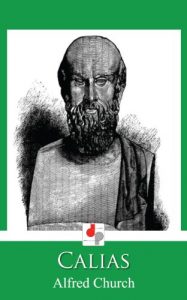I have said that it was a bold change by which Virgil sought to shape the legend of Elissa or Dido to suit the purpose of his own poem. Bold indeed it was, for he brings together in the Queen of Carthage and the Hero of Troy, persons who must have been separated from each other in time by more than two hundred years. Ascanius, he tells us himself in the Aeneid, was to found Alba, and at Alba the kingdom should remain for three hundred years, till the priestess of Vesta should bear a son to Mars, who should found the great city of Rome. There must therefore have been more than three hundred years between the coming of Aeneas into Italy and the founding of Rome. But, on the other hand, it was commonly agreed that Carthage was not a hundred years older than Rome. If we are to follow Justin, from whom I have taken the legend told in the first chapter, its foundation may be put in the year 850; but it must not be supposed that this date is as certain as that of the Declaration of American Independence, or that of the Battle of Waterloo.
The legend tells us that the first founders of Carthage came from Tyre. Very likely this is true; it is certain that they belonged to the nation of which Tyre was the chief city, the Phoenicians. This people dwelt in the little strip of land (not much larger than the American State of New Hampshire, or about twice the size of the English county of Yorkshire) which is called Palestine, and which occupies the southeastern corner of the Mediterranean coast. The inland tribes of this people, who are known to us in the Bible history under the name of Canaanites, were subdued and nearly destroyed by the Hebrews, when, after their escape from slavery in Egypt, they invaded the country about fourteen hundred years before Christ. But many of the dwellers of the coast remained unsubdued. In the south were the Philistines with their five cities, almost always at war with their Hebrew neighbours, sometimes almost conquering them, and sometimes, as in the days of David and Solomon, paying tribute.
In the north, again, were the great cities of Tyre and Sidon. Between these and the Hebrews there seems to have been commonly friendship. They were a nation of seamen and traders, and they had to import the food which they did not wish, or perhaps were not able, to grow for themselves. For this food they paid either with the produce of their own artists and handicrafts men, with timber cut in the cedar forest of Lebanon, or work in bronze and iron, or rich purple dyes, or with merchandize which they had themselves imported. As traders, indeed, they travelled very far, and while seeking new markets in which to buy and sell, they made great discoveries. They went as far south, some say, as the Cape of Good Hope, certainly as far as Sierra Leone; and as far north as Britain, from which they fetched tin, and probably copper. But I shall have more to say of this hereafter. It was, however, chiefly the coasts of the Mediterranean that they were accustomed to visit; and along these it was that they established their trading posts. It is the story of the most famous of these posts that I have now to tell...
The legend tells us that the first founders of Carthage came from Tyre. Very likely this is true; it is certain that they belonged to the nation of which Tyre was the chief city, the Phoenicians. This people dwelt in the little strip of land (not much larger than the American State of New Hampshire, or about twice the size of the English county of Yorkshire) which is called Palestine, and which occupies the southeastern corner of the Mediterranean coast. The inland tribes of this people, who are known to us in the Bible history under the name of Canaanites, were subdued and nearly destroyed by the Hebrews, when, after their escape from slavery in Egypt, they invaded the country about fourteen hundred years before Christ. But many of the dwellers of the coast remained unsubdued. In the south were the Philistines with their five cities, almost always at war with their Hebrew neighbours, sometimes almost conquering them, and sometimes, as in the days of David and Solomon, paying tribute.
In the north, again, were the great cities of Tyre and Sidon. Between these and the Hebrews there seems to have been commonly friendship. They were a nation of seamen and traders, and they had to import the food which they did not wish, or perhaps were not able, to grow for themselves. For this food they paid either with the produce of their own artists and handicrafts men, with timber cut in the cedar forest of Lebanon, or work in bronze and iron, or rich purple dyes, or with merchandize which they had themselves imported. As traders, indeed, they travelled very far, and while seeking new markets in which to buy and sell, they made great discoveries. They went as far south, some say, as the Cape of Good Hope, certainly as far as Sierra Leone; and as far north as Britain, from which they fetched tin, and probably copper. But I shall have more to say of this hereafter. It was, however, chiefly the coasts of the Mediterranean that they were accustomed to visit; and along these it was that they established their trading posts. It is the story of the most famous of these posts that I have now to tell...
![Baixar The Story of Carthage [Quintessential Classics] [Illustrated] (English Edition) pdf, epub, eBook](https://br.99ebooks.net/wp-content/uploads/2017/05/51pJ7L-8yFL.jpg)











